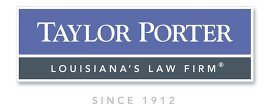Taylor Porter Patent Law Attorney John Runnels Featured in 10/12 Industry Report
February 22, 2016
 Taylor Porter Partner and patent law attorney John Runnels is featured in the 10/12 Industry Report, First Quarter Edition, in a Patent Law Q&A feature, "Protect Your Assets - What Today's Manufacturers Should Know About Patent Law."
Taylor Porter Partner and patent law attorney John Runnels is featured in the 10/12 Industry Report, First Quarter Edition, in a Patent Law Q&A feature, "Protect Your Assets - What Today's Manufacturers Should Know About Patent Law."
Practicing law since 1985,Runnels is engaged primarily in the practice of patent law, including chemical patent prosecution, biotech patent prosecution, patent licensing, university technology transfer and related matters. Runnels is admitted to the bar in Louisiana, New York and the United States Patent and Trademark Office. He is a member of the American Intellectual Property Law Association, American Bar Association Section of Intellectual Property, Louisiana State Bar Association, Baton Rouge Bar Association and Association of University Technology Managers.Runnels has a B.S. in chemistry from Louisiana State University and an M.S. in chemistry from California Institute of Technology.
Runnels discusses the questions manufacturers should be concerned about as their activity involves innovation, research and development, new products or processes, or the use of products, processes or technologies created by other entities.
The text of Runnels' answers are provided below, courtesy of the 10/12 Industry Report.
What should manufacturers consider when implementing or updating their intellectual property strategies in 2016?
JOHN RUNNELS (TAYLOR, PORTER, BROOKS & PHILLIPS): Intellectual property can be one of a company’s most valuable assets. A patent gives its owner the right to exclude others from making, using, selling, offering to sell or importing the patented invention. Not all discoveries are patentable. Even where an invention is otherwise patentable, patent rights can be lost with the passage of time.
In the first instance, a manufacturer should make sure that its employment contracts and policies expressly require employees to assign all inventions to the employer, or at least to assign all inventions related to the manufacturer’s line of business. Those who go through the patenting process for the first time are often surprised to learn that an employer does not necessarily own inventions made by its employees. Patent policies are sometimes put into place only after the first horse is already out of the barn. The recommended practice is for employment contracts to expressly require assignment of employees’ inventions.
A manufacturer should also have procedures to encourage the prompt disclosure of new inventions to a single office. That office should promptly evaluate all new disclosures and, where warranted, should confer with a patent attorney or patent agent. Sometimes a quick Google search is all that is needed to determine that a promising idea is not new after all. Google can save you time and money before you confer with an attorney. If nothing relevant turns up on Google, and if an invention might be commercially valuable, then it is time to confer with a patent professional.
Until a patent application has been filed, information about any new invention should be kept confidential. In general, no sales or other commercial uses should be made involving a new invention before a patent application has been filed. In narrow circumstances, there can sometimes be exceptions. A patent attorney or patent agent should be consulted to discuss whether an exception might apply in a particular case.
If the decision is made not to file a patent application, then the company should consider whether instead to maintain a new discovery as a trade secret. Trade secret information should only be disclosed to those having a need to know and only where there is a written agreement in place requiring the recipient to keep the information confidential.
What is new or most important in today’s patent law that manufacturers should be aware of?
RUNNELS: Patent law is a complex and rapidly changing field. Two topics will be discussed here, but these topics just scratch the surface.
Foreign patents can sometimes be important. Foreign patents can also be expensive. A United States patent only has effect in the United States. Where there are international markets for a particular product, a company will need to weigh the costs and benefits of seeking patent coverage in other countries. Some jurisdictions are especially strict about timeliness of patent filings. Premature public disclosures can jeopardize potential patent rights. Especially in cases where foreign patents might be considered, take precautions that nothing is publicly announced concerning new discoveries before a patent application has been filed, or until a decision is made not to file a patent application.
Under the America Invents Act (AIA), premature disclosures also have the potential to create problems even in the United States. The AIA is often known primarily for its “first-to-file” provisions. Where two people claim the same invention, it was formerly the case in the United States that the “first to invent” would be awarded priority, at least in principle. Priority instead is now awarded to the “first to file.” Although “first to file” represents the most widely known change in the law, it is not the most significant aspect. Only a very small fraction of patent applications actually end up in priority disputes; certainly, for those few patent applications, “first to file” versus “first to invent” can make a huge difference. However, for the vast majority of patent applications, the more significant aspects of the AIA are those that changed the scope of what is considered “prior art,” i.e., the body of knowledge against which the patentability of a new invention is judged. In general, the scope of “prior art” has been broadened, although in some circumstances it has been narrowed.
Broadly speaking, “prior art” encompasses information that was publicly available before a patent application was filed. In some circumstances, a disclosure made by the inventor less than one year before the filing date will not count as “prior art.” However, even public disclosures made by the inventor are considered “prior art” if made more than 12 months before a patent application is filed. Further, the United States Patent and Trademark Office has taken the position that, even for public disclosures within 12 months of the filing date, where someone else learns of an invention through the inventor’s own disclosure and where that person then makes a new public disclosure with even slight modifications, then that new disclosure can be considered “prior art” that could ultimately bar the original inventor’s patent application. Whether the courts will agree with the USPTO remains to be seen. In the interim, the prudent course is to confer with your patent professional earlier rather than later, and to defer all public disclosures related to an invention until a patent application is filed or until the decision is made not to file.
Read our Case Studies
See how we can help. Contact us today
- Disclaimer
- © Taylor, Porter, Brooks & Phillips L.L.P. All rights reserved.



